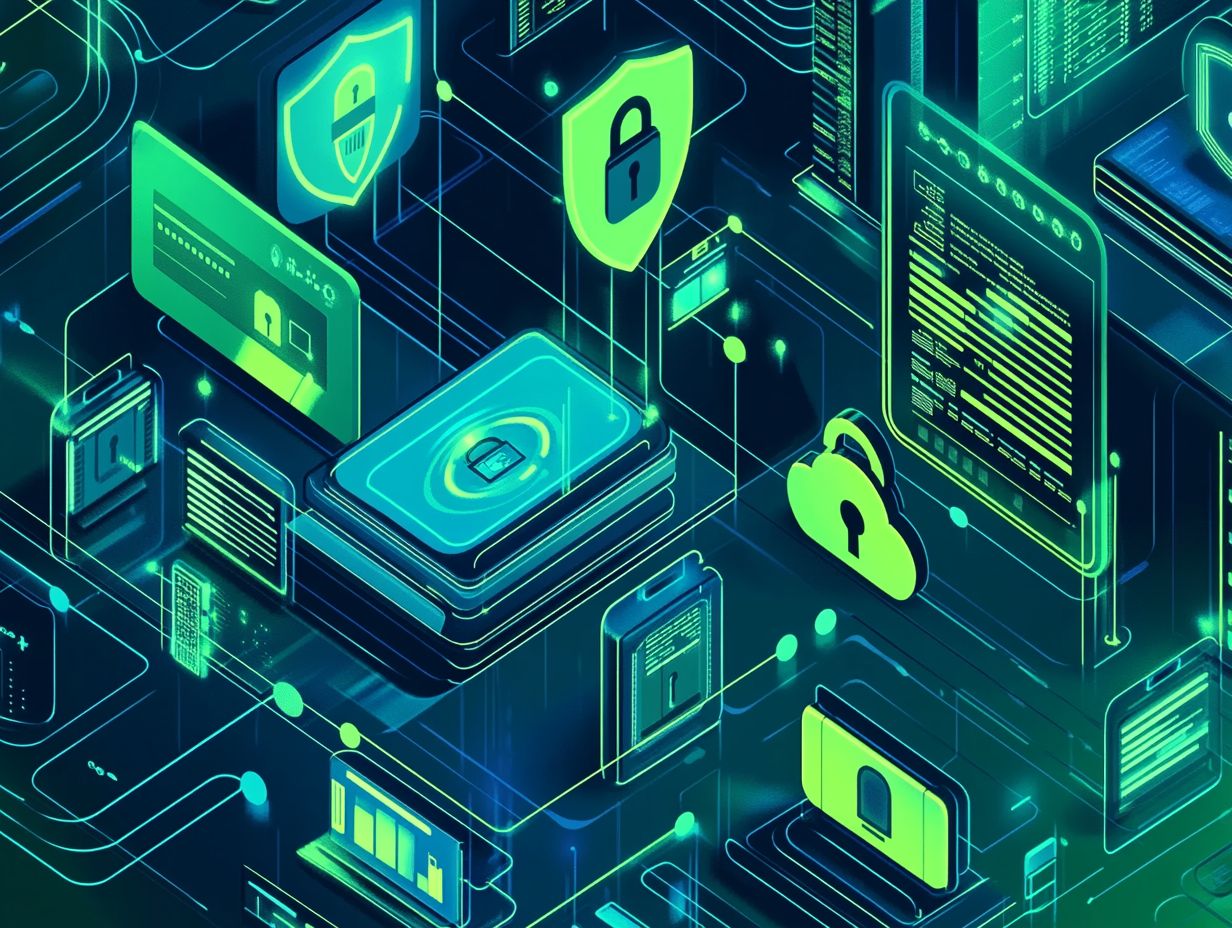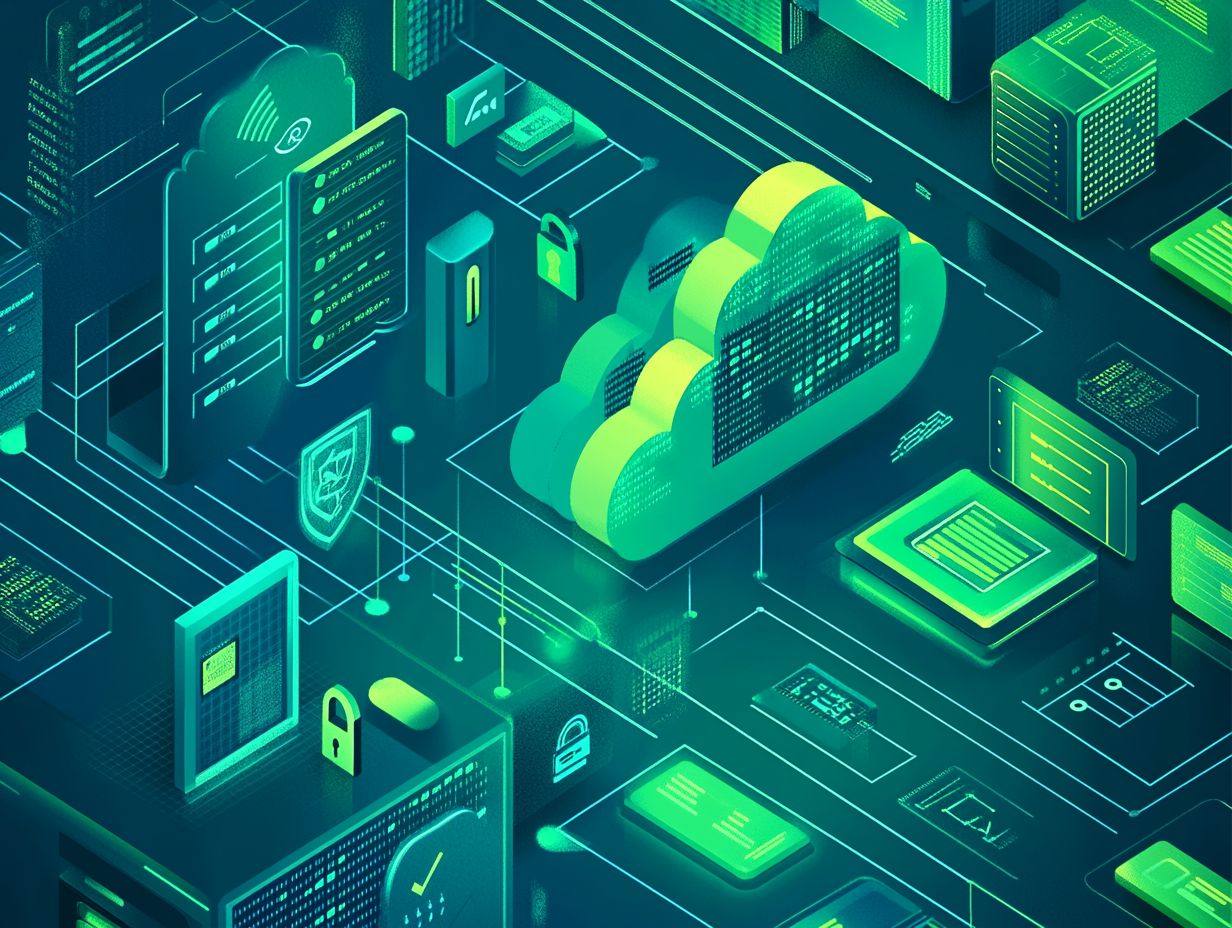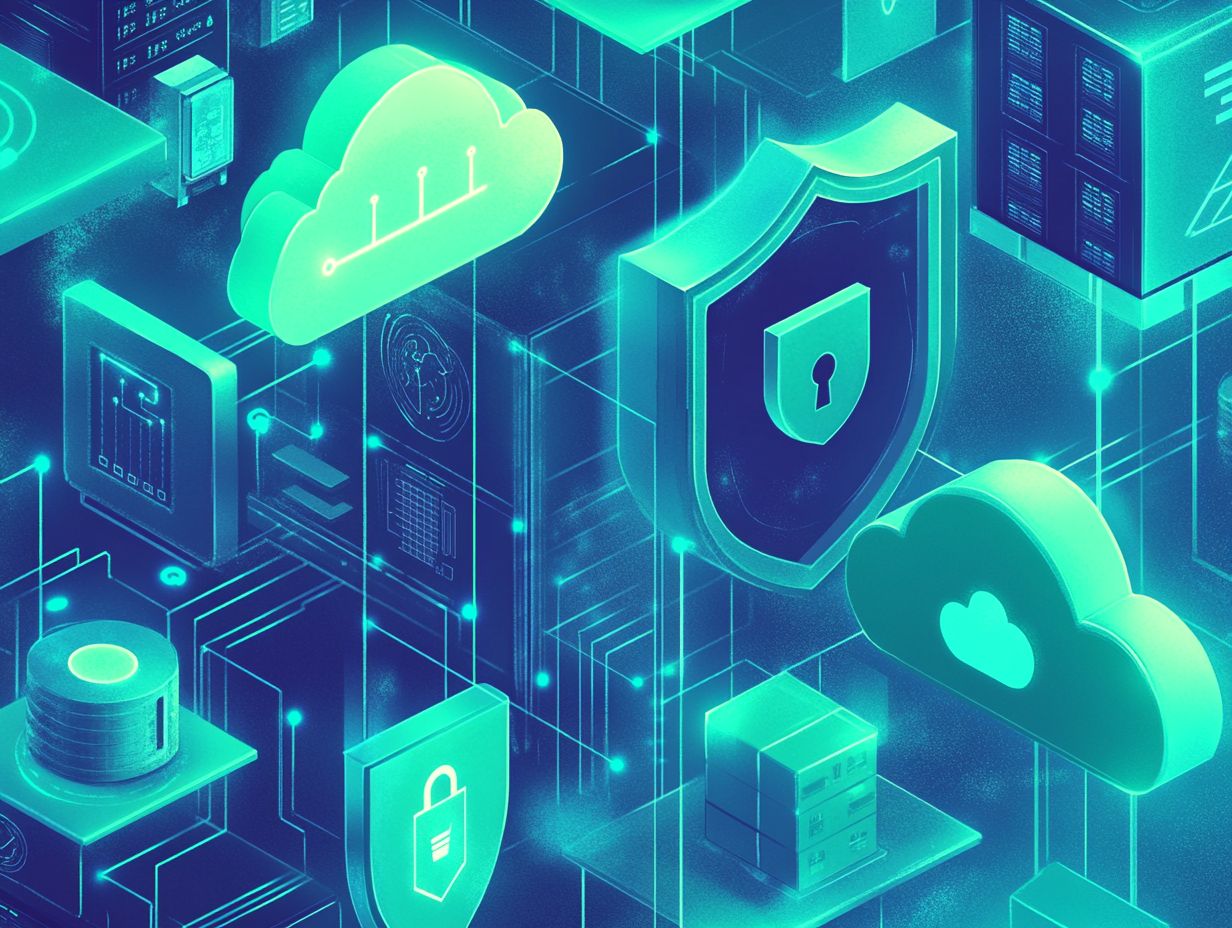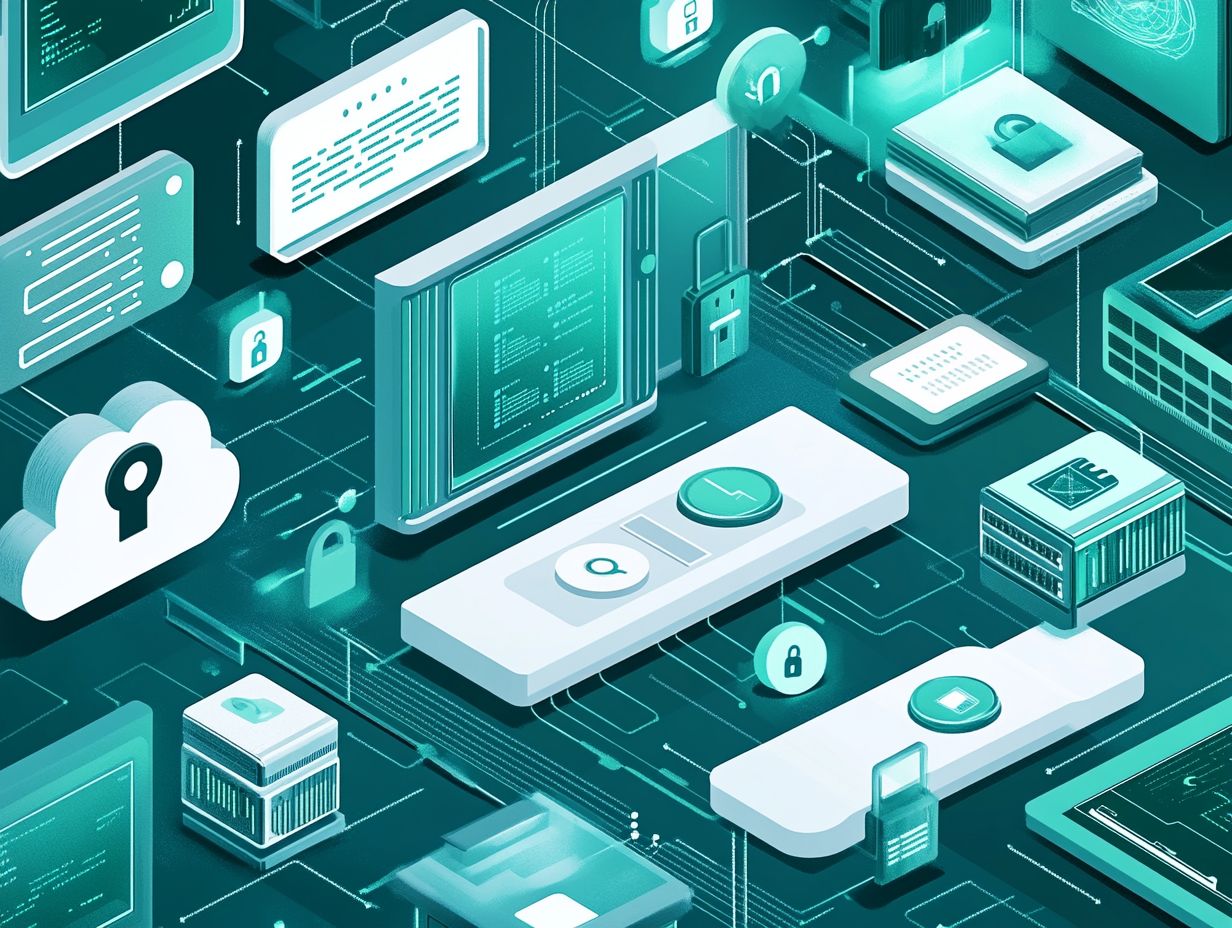Essential Features of a Cloud Security Solution
In today’s digital world, businesses rely heavily on cloud services. Understanding cloud security is crucial.
This article explores the core features of cloud security. It covers aspects like data encryption, access control, and threat detection.
You will discover key factors to consider when selecting the right solution tailored to your needs. The article also includes best practices for effective implementation and ongoing maintenance.
Whether you are a business owner or an IT professional, this guide will provide you with insights necessary to protect your cloud environment effectively.
Contents
- Key Takeaways:
- Key Features of a Cloud Security Solution
- Choosing the Right Cloud Security Solution
- Implementing and Maintaining a Cloud Security Solution
- Frequently Asked Questions
- What are the essential features of a cloud security solution?
- How does data encryption play a role in a cloud security solution?
- Why is access control important in a cloud security solution?
- What is the role of threat detection and prevention in a cloud security solution?
- How does data backup and recovery contribute to a cloud security solution?
- Why is continuous monitoring necessary in a cloud security solution?
Key Takeaways:

Data encryption and protection are crucial features of a cloud security solution, incorporating key technologies in cloud security solutions to ensure the confidentiality and integrity of sensitive information.
Access control and user management are essential for regulating user privileges and preventing unauthorized access to cloud resources.
Threat detection and prevention capabilities are necessary to identify and mitigate potential security breaches in the cloud environment.
What is Cloud Security?
Cloud security is a comprehensive framework designed to protect your cloud computing environments. It ensures that your data privacy and integrity remain intact as cyber threats evolve.
It includes various security measures and practices aimed at safeguarding sensitive information, preventing data breaches, and maintaining compliance with regulations like GDPR and HIPAA.
Whether you are utilizing public or private cloud infrastructures, cloud security addresses the challenges you may face. It also aligns with risk management frameworks such as NIST 800-53, which helps organizations manage their information security risks.
Key components of cloud security include:
- Robust data protection strategies
- Utilizing encryption and access controls
- An effective security architecture that incorporates secure configurations
- Regular vulnerability assessments
Having incident response plans in place is crucial for addressing potential attacks swiftly and efficiently.
As you navigate various cloud models, such as hybrid and multi-cloud strategies, you will encounter unique security challenges and opportunities.
It is also essential for cloud service providers (CSPs) to clearly define rights and responsibilities concerning security. This clarity ensures that both providers and clients collaborate effectively to mitigate risks and protect sensitive data.
Key Features of a Cloud Security Solution

A robust cloud security solution includes a range of critical features that boost the security posture of your cloud environments, focusing on the key elements of a cloud security strategy.
Key features include automated compliance check tools and threat intelligence resources that keep you informed of potential risks.
You will also find security policies designed to enforce least privilege access. Strong user authentication measures ensure that only authorized users can access sensitive data.
By adopting continuous integration and deployment practices, you can integrate security throughout the development lifecycle. This approach effectively mitigates risks associated with your cloud workloads.
Act now to ensure your cloud security. Don’t wait until it’s too late secure your data today!
Data Encryption and Protection
Data encryption and protection are essential pillars of cloud security. To enhance your understanding, it’s important to learn how to choose a cloud security provider that ensures your sensitive information remains confidential and shielded from unauthorized access.
This process utilizes encryption keys and various algorithms to encrypt data both in transit and at rest. This safeguards it against potential data breaches and supply chain attacks.
Implementing strong security configurations greatly enhances your data protection strategy within cloud-native applications.
To achieve effective encryption, you can leverage methods such as:
- Symmetric encryption: This method uses a single key for both encryption and decryption.
- Asymmetric encryption: This method uses two keys: a public key for encryption and a private key for decryption.
These techniques offer different levels of security and performance. Symmetric encryption is often faster but may be less secure if the keys are compromised.
Ensuring data encryption at rest is particularly crucial; it protects stored information from unauthorized access, even if physical storage devices are stolen.
Key management systems play a vital role in this landscape. They manage the lifecycle of encryption keys, ensuring they are generated, stored, and rotated securely.
Adopting best practices for data protection in cloud environments is crucial! This involves employing strong access controls, conducting regular security audits, and integrating relevant security measures and tools to effectively mitigate vulnerabilities.
Access Control and User Management

Access control and user management are pivotal elements of cloud security. They help mitigate risks by ensuring that only authorized individuals can access sensitive cloud resources.
Embracing Identity and Access Management (IAM) solutions allows you to implement least privilege principles. This grants users only the minimum access necessary to perform their roles while maintaining rigorous user authentication processes.
This layered approach to access control is essential for safeguarding your cloud-native applications and workloads from unauthorized access.
Different access control models, particularly Role-Based Access Control (RBAC) and Attribute-Based Access Control (ABAC), are instrumental in orchestrating user permissions.
RBAC allows you to assign access based on user roles, streamlining permission management across teams. On the other hand, ABAC provides a more granular approach by evaluating user attributes and environmental factors.
In cloud environments, these models enable dynamic and flexible access management that adapts to your evolving security needs.
Implementing robust user authentication methods, such as multi-factor authentication (MFA), significantly bolsters security. This introduces additional verification steps, minimizing the risk of unauthorized access and contributing to a more secure cloud ecosystem.
Threat Detection and Prevention
Threat detection and prevention keep your cloud secure. They help you identify and respond to cyber attacks quickly.
By leveraging threat intelligence feeds, you stay informed about emerging threats and vulnerabilities. This aids in crafting proactive incident response plans that mitigate potential damage.
Utilizing advanced threat detection tools enhances your security measures and ensures continuous monitoring of your cloud environments.
In this landscape, Security Information and Event Management (SIEM) systems become critical. They aggregate and analyze security data in real time, offering valuable insights into potential threats.
Continuous monitoring solutions further strengthen this capability. They consistently evaluate network activity to spot anomalies.
Integrating threat intelligence into these systems is essential. It enriches data analysis, allowing for quicker identification of known threats and more informed decisions.
By adopting these comprehensive strategies, you significantly elevate your incident response capabilities. This transforms reactive measures into proactive defenses against the ever-evolving threat landscape.
Now is the time to evaluate your current cloud security measures and ensure they are robust enough to protect your sensitive information!
Compliance and Audit Features

Compliance and audit features are essential for ensuring your cloud security measures align with industry standards and regulations like HIPAA, GDPR, and PCI 3.2.
These features automate compliance checks. They also provide clear visibility into your security policies, helping you follow governance standards.
Conducting regular compliance audits allows you to identify potential gaps in your security posture. You can then take corrective actions without delay.
Committing to compliance not only protects your sensitive data but also boosts your confidence in your security measures. It helps mitigate the risk of hefty financial penalties and reputational damage that can arise from non-compliance.
By integrating automation into your compliance processes, you can streamline repetitive tasks like documentation and reporting. This enhances efficiency while cutting down on human error.
Automated audits deliver real-time insights and generate comprehensive reports. This enables your security team to quickly demonstrate compliance and make well-informed decisions.
Ultimately, the combination of compliance and automation strengthens your cloud security. This allows you to cultivate a secure and reliable environment for your operations while fostering trust with customers and stakeholders.
Choosing the Right Cloud Security Solution
Selecting the ideal cloud security solution is crucial for your organization to effectively safeguard its cloud environments. Understanding how to assess cloud provider security features can help in making an informed decision.
Given the constantly shifting threat landscape and varying risk management needs, you should assess different companies that provide cloud services by scrutinizing their security architecture, features, and compliance capabilities.
You should also consider aspects like scalability and ease of integration, as well as the capacity to adapt to evolving security demands.
This comprehensive evaluation empowers you to craft a robust strategy for cloud security. Start evaluating your options today to secure your cloud environment!
Factors to Consider
When selecting a cloud security solution, it’s essential to consider several critical factors, including the key features of cloud solutions, to ensure your cloud workloads are comprehensively protected.
Focus on the effectiveness of the security tools in addressing specific risks, the solution s compliance with industry regulations, and its ability to seamlessly manage security configurations across various cloud environments.
Don t overlook the vendor s track record in incident response and support services; this insight is crucial for making an informed decision.
Tailored security tools are vital for identifying and mitigating the unique vulnerabilities that come with different cloud technologies, particularly when considering the key metrics for measuring cloud security effectiveness.
Compliance requirements hold significant weight. Failing to meet these standards can lead to legal consequences and financial penalties, underscoring the importance of solutions that proactively address regulations.
A user-friendly management interface not only streamlines the configuration process but also boosts user adoption among teams. This promotes a collaborative approach to security.
Together, these factors enhance the overall effectiveness of cloud security solutions, allowing you greater adaptability to emerging threats and evolving organizational needs, especially when considering what features to look for in a cloud provider.
Implementing and Maintaining a Cloud Security Solution
Implementing and maintaining a cloud security solution is an essential undertaking that demands meticulous planning and execution, including understanding the key considerations for cloud security architecture, to ensure a robust security posture.
To excel in cloud security, you should embrace best practices such as adopting a continuous integration (CI) approach, regularly updating your security measures, and consistently monitoring the effectiveness of your security configurations.
It’s also crucial for you to engage in ongoing risk management. This will allow you to adapt to emerging vulnerabilities and threats in the constantly evolving cloud landscape.
Best Practices and Tips
Adopting best practices for cloud security is essential. It helps your organization protect its cloud environments from potential threats.
Focus on implementing strong user login methods and effective data loss prevention strategies. Prepare comprehensive incident response plans to swiftly address any security incidents that may arise.
By regularly updating your security measures and conducting vulnerability assessments, you’ll significantly strengthen the security posture of your cloud workloads.
To elevate your cloud security, utilize multifactor authentication. This approach adds an invaluable extra layer of protection by requiring more than one method of verification. It ensures that access to sensitive data is tightly controlled.
Fostering a culture of security within your organization is vital! Regularly train your employees on security awareness and emphasize the importance of recognizing phishing attempts and maintaining strong passwords. This can make a significant difference.
Encourage open discussions about security concerns to cultivate a proactive atmosphere. Implement encryption for data at rest and in transit to safeguard sensitive information from unauthorized access. This ensures that your organization can effectively mitigate risks and respond to potential threats.
Frequently Asked Questions
What are the essential features of a cloud security solution?
Some essential features of a cloud security solution include data encryption, access control, threat detection and prevention, data backup and recovery, and continuous monitoring.
How does data encryption play a role in a cloud security solution?
Data encryption is vital because it protects your data from unauthorized access. It ensures that the data is unreadable unless the authorized user has the encryption key.
Why is access control important in a cloud security solution?
Access control is crucial as it allows organizations to control who has access to their data. It helps prevent unauthorized users from accessing sensitive information and ensures that only authorized users can view and interact with data.
What is the role of threat detection and prevention in a cloud security solution?
Threat detection and prevention is a critical feature that helps identify and mitigate potential security threats. This feature uses advanced tools and techniques to detect and prevent attacks, making the cloud environment safer for data storage and processing.
How does data backup and recovery contribute to a cloud security solution?
Data backup and recovery is essential as it ensures that data is not lost in case of a security breach or disaster. It allows organizations to restore their data from a secure backup and continue their operations without significant disruptions.
Why is continuous monitoring necessary in a cloud security solution?
Continuous monitoring is crucial as it provides real-time visibility into potential security threats. It allows organizations to proactively identify and address any security issues, minimizing the risk of data breaches and ensuring the overall security of their cloud environment.
For more information on implementing these best practices, don t hesitate to reach out!






